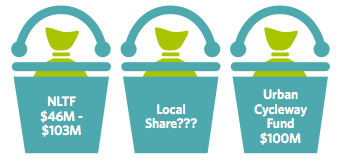
Some facts and figures in support of investment in cycling-
- The Urban Cycleway Programme offers a 2 to 1 deal for Councils. Roughly speaking, for every dollar you raise, the Land Transport Fund can provide a dollar, and the UCP another.
- There's a huge pent-up demand to swap short car trips for cycling. Parts of Wellington have experienced almost 90% increases in cycle commuting in recent years (Statistics NZ).
- New cycling facilities rapidly attract new users (Monsere et al, 2014, NITC)
- After the quakes, Christchurch's Share an Idea survey gathered overwhelming support for a cycling and walking city.
- 1.5 million New Zealanders cycle regularly.
- Cycling facilities help people make journeys independently - Lots of people can't drive- in the UK, it's 42% of the population including children (UK Sustainable Development Commission, 2011)
- Cycling is the third-fastest increasing activity in NZ after swimming and walking (Sport NZ survey)
- Rod Drury (Xero) and Sam Morgan (TradeMe) have both stated that the mountain-bike trails near Wellington are key attractors for skilled workers for their businesses.
- 49% of Kiwis' trips to work are 5km or less (Statistics NZ, 2013)
- NZ research shows that “transforming urban roads over the next 40 years, using best practice physical separation on main roads and bicycle-friendly speed reduction on local streets, would yield benefits 10–25 times greater than costs” (Macmillan et al, 2014)
- Switching to cycling has a health benefit-cost ratio of 9 to 1 (Mueller et al., 2015). New Zealand has the fourth-highest obesity rate in the world, which costs us $622 million in direct health cost per year (2006 figures), and between $98m and $222m indirect costs (Lal et al., 2012)
- The benefit-cost ratios of the Roads of National Significance averages out at 1.5 to 1 (Pickford M., 2013)
- Pollution from traffic causes 259 adult deaths per year in New Zealand, and PM10 emissions cause losses of $942 million per year (Kuschel et al., 2012)
- New York put in separated bike lanes and improvements on parts of 9th Avenue, Manhattan. There was up to 49% increased retail sales. There was also a 58% reduction in injuries to all street users. (NYC publication)
- One US study showed properties within 35 meters of bike paths sell for US $8,800 more.
- Cycling means jobs. Count up your local bike shops and how many they employ. Imagine that number doubled, when cycling numbers increase. An EU study tallied 650,000 jobs in the 'cycling sector'. (ECF, 2014)
- More cyclists on the road means safer cycling (Forbes/OECD data)
- Running a car costs around $10,000 per year for the average Kiwi family (AA)
- Poor urban design creates the need for car journeys. Making sure that all new communities can access schools, shops and work without needing a car is simply a matter of good planning, a core responsibility of Councils, and a cost-neutral or beneficial policy.
ends
